The Wooden Interior Door Market is estimated to be valued at USD 62.6 billion in 2025 and is projected to reach USD 102.0 billion by 2035, registering a compound annual growth rate (CAGR) of 5.0% over the forecast period. Between 2020 and 2025, the market expands from USD 49.1 billion to USD 62.6 billion, contributing an incremental gain of USD 13.5 billion, which accounts for roughly 25.5% of the total projected growth.
This phase is driven by rising demand for aesthetically pleasing, durable, and eco-friendly door solutions in residential and commercial construction. Increasing investments in real estate development and renovation projects, especially in emerging economies, support market growth. The growing trend toward customized interior designs and sustainable building materials further propels demand.
From 2026 to 2030, the market advances from USD 65.8 billion to USD 79.9 billion, adding USD 14.1 billion to the overall increase. This period witnesses expansion driven by technological improvements in manufacturing processes, enhanced surface finishes, and the integration of smart home features. The latter half of the forecast period, from 2031 to 2035, sees the market accelerate from USD 83.9 billion to USD 102.0 billion, contributing USD 18.1 billion.
This growth is fueled by increased urbanization, rising disposable incomes, and heightened consumer preference for premium and energy-efficient interior doors. The wooden interior door market is positioned for robust growth through 2035, supported by evolving architectural trends, sustainability initiatives, and expanding construction activities worldwide.
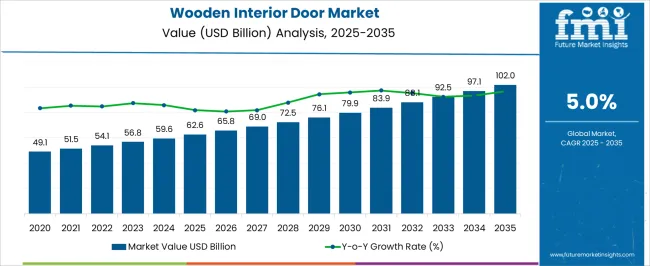
| Metric | Value |
|---|---|
| Wooden Interior Door Market Estimated Value in (2025 E) | USD 62.6 billion |
| Wooden Interior Door Market Forecast Value in (2035 F) | USD 102.0 billion |
| Forecast CAGR (2025 to 2035) | 5.0% |
Enhanced awareness of indoor acoustics, energy efficiency, and architectural cohesion is influencing consumer preferences toward quality door systems. Manufacturers are focusing on integrating engineered wood, minimalist designs, and sustainable raw materials to address both performance and environmental concerns. The demand for thermally efficient and visually cohesive interiors is leading to wider adoption of high-quality wooden doors, especially in new housing and renovation projects.
The market is also being shaped by innovations in finishing technologies and pre-hung door units that reduce installation time and labor costs. Looking forward, shifting urban lifestyles, increasing disposable incomes, and custom design offerings are expected to accelerate product diversification and category expansion across both residential and commercial interiors.
The wooden interior door market is segmented by product type, mechanism, end-use, and geographic regions. By product type, the wooden interior door market is divided into Panel Door, Bypass Door, Bifold Door, Pocket Door, and Others. In terms of the mechanism, the wooden interior door market is classified into Swinging, Sliding, Folding, and Others. The wooden interior door market is segmented by end-use into Residential, Non-residential, and Others. Regionally, the wooden interior door industry is classified into North America, Latin America, Western Europe, Eastern Europe, Balkan & Baltic Countries, Russia & Belarus, Central Asia, East Asia, South Asia & Pacific, and the Middle East & Africa.
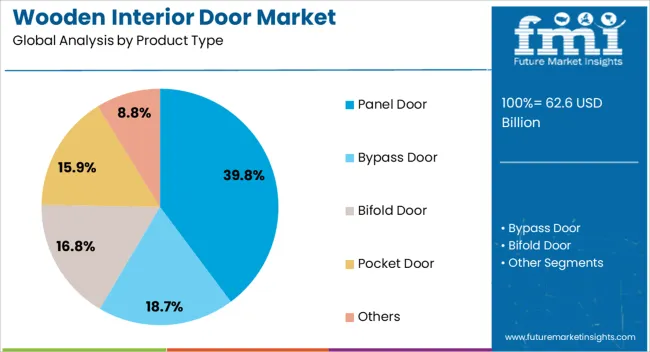
Panel doors are expected to contribute 39.80% of the total revenue in the wooden interior door market by 2025, positioning them as the leading product type. Their prominence is being driven by strong consumer acceptance of classic and versatile designs that offer both aesthetic and functional value.
Panel doors provide enhanced insulation and durability, making them well-suited for varied climatic and usage conditions. Additionally, compatibility with traditional and modern interior themes has supported their adoption in both new construction and renovation projects.
Manufacturers are further optimizing panel door production with engineered wood cores, customizable panel configurations, and eco-friendly finishes, aligning with evolving consumer and regulatory demands.
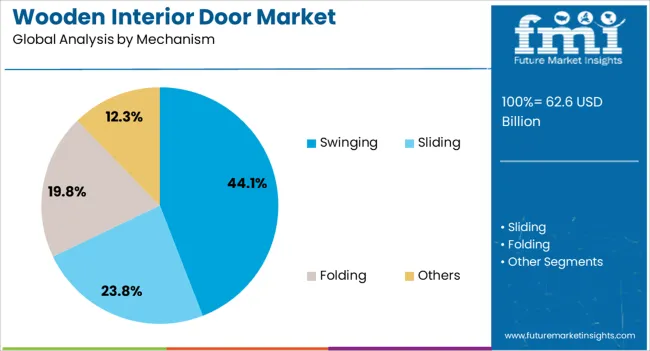
Swinging doors are projected to hold 44.10% of the market share by 2025, establishing them as the dominant mechanism type. This segment’s growth is being supported by ease of installation, low maintenance requirements, and widespread design compatibility with conventional architectural layouts.
Swinging mechanisms continue to be favored for their robust performance in high-traffic residential spaces, offering smooth operation and noise-dampening benefits. The adaptability of swinging doors with a variety of handle sets, locking systems, and decorative finishes has further broadened their application across interior zones such as bedrooms, kitchens, and hallways.
As cost-efficiency and reliability remain key purchasing criteria, swinging mechanisms are expected to maintain their lead in the market.
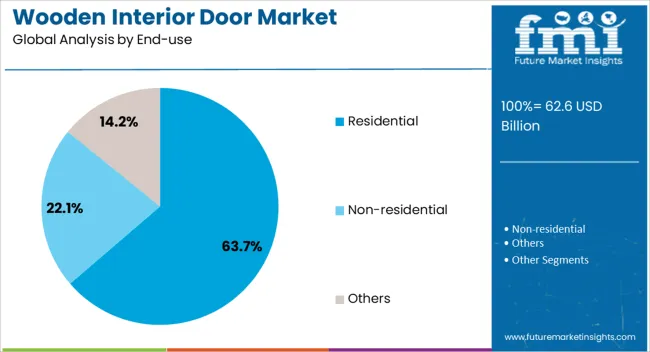
Residential applications are expected to account for 63.70% of the total wooden interior door market revenue in 2025, making this the most significant end-use category. The rising number of housing developments, urbanization, and demand for functional yet stylish interiors is influencing growth in this segment.
Increasing consumer focus on privacy, sound control, and thermal efficiency within homes has contributed to higher spending on premium door solutions. Customization in terms of wood type, design detailing, and stain options has further elevated demand among homeowners and interior designers.
Additionally, government incentives for affordable housing and energy-efficient buildings are encouraging greater installation of quality wooden doors in the residential sector.
The wooden interior door market is influenced by trends in customization, eco-friendly material preference, advancements in woodworking technology, and strong economic growth that boosts renovation activities. These dynamics drive the demand for high-quality, durable, and unique wooden doors across residential and commercial sectors.
The demand for customized wooden interior doors has seen significant growth as homeowners and businesses seek unique designs that reflect personal style. Custom doors allow for a range of materials, finishes, and configurations, offering a more tailored fit for specific interior aesthetics. This trend is driven by the increasing popularity of high-end, bespoke furniture and home décor. In the residential market, custom doors are often chosen to complement contemporary designs, while in the commercial space, they help create a distinctive ambiance. Manufacturers are responding by providing a wide variety of customizable options, including unique wood types, panel designs, and finishes. As consumers prioritize personalization, the market for customized wooden doors is expanding rapidly.
The preference for eco-friendly and durable materials in interior doors is pushing the demand for wooden options. Wood is considered a natural and renewable resource, which appeals to consumers looking for environmentally conscious solutions without compromising on quality or aesthetic appeal. Wooden interior doors, particularly those made from sustainably sourced timber, offer durability and long-term value, with a lifespan that outlasts many alternative materials. As more people seek to make sustainable choices for their homes and businesses, the popularity of wooden doors has been on the rise. This trend is reflected in the growing number of manufacturers offering certifications and assurances of sustainability in their production processes.
Advancements in woodworking technology have greatly improved the precision and quality of wooden interior doors. Computer-aided design (CAD) software and automated machinery enable manufacturers to create highly accurate cuts and intricate designs with less material waste and faster production times. This has led to a broader range of door styles, including intricate carvings and custom finishes, while maintaining superior quality. The use of modern techniques also improves the structural integrity of the doors, reducing the likelihood of warping or cracking over time. As technology continues to evolve, the ability to produce high-quality wooden doors more efficiently has become a key driver in the market’s growth.
Economic growth and the increase in home renovations are driving the demand for wooden interior doors. With a recovering housing market and higher disposable incomes, more homeowners are investing in upgrading their interiors, often opting for wooden doors to enhance the overall look of their spaces. The real estate boom in urban areas, combined with rising demand for quality interiors in commercial spaces, further strengthens this trend. Renovations and remodeling projects, particularly in the residential sector, are increasingly incorporating high-quality wooden doors due to their timeless appeal and ability to enhance property value. As renovation activity continues to rise, the market for wooden interior doors is expected to maintain steady growth.
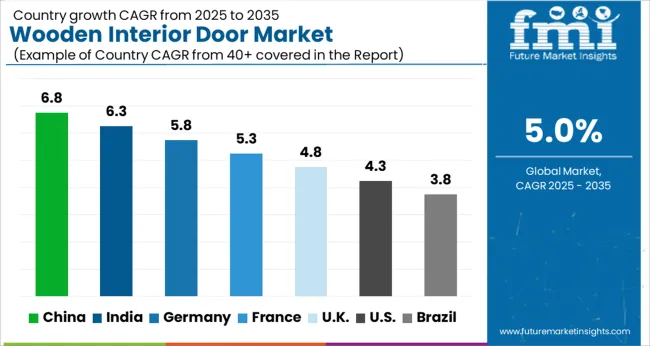
The wooden interior door market is projected to grow globally at a CAGR of 5.0% from 2025 to 2035, driven by increasing construction activities, urbanization, and demand for aesthetically pleasing, sustainable interior solutions. China leads with a CAGR of 6.8%, fueled by rapid urbanization, growing residential and commercial construction, and a rising preference for sustainable, eco-friendly building materials. India follows at 6.3%, supported by a booming real estate market, increased demand for modern interior designs, and the expansion of the hospitality sector. Germany grows at 5.8%, with strong demand from both residential and commercial segments, driven by the country’s emphasis on quality craftsmanship and sustainability.
The United Kingdom achieves a CAGR of 4.8%, boosted by renovations in both residential and commercial properties and a shift towards customized and energy-efficient door solutions. The United States records a CAGR of 4.3%, influenced by increasing home construction and renovation activities, as well as a growing preference for premium, durable interior doors. This growth trajectory reflects the increasing need for high-quality, sustainable, and aesthetically pleasing wooden interior doors across various construction and renovation projects globally.
The UK’s wooden interior door market grew at a CAGR of 3.5% from 2020 to 2024 and is expected to rise to 4.8% during 2025-2035. The earlier growth was moderate, driven by steady demand in the residential sector and renovations in both private and commercial spaces. The market is projected to accelerate in the coming decade, mainly due to the increasing preference for customizable and energy-efficient wooden doors. Additionally, rising awareness of sustainability and eco-friendly building materials will spur demand for wooden doors made from sustainable wood sources. The ongoing trends in interior design, such as the use of wood for aesthetic and insulation purposes, will drive market growth further. The UK’s growing focus on energy-efficient and long-lasting construction materials is expected to significantly boost the demand for wooden interior doors in the upcoming decade.
China’s wooden interior door market is expected to grow at a CAGR of 6.8% during 2025-2035, surpassing the global CAGR of 5.0%. The market grew at a CAGR of 5.5% from 2020 to 2024, supported by rapid urbanization, robust real estate development, and growing middle-class demand for modern home and office interiors. The acceleration in the coming decade is attributed to China's continuous infrastructure development, expanding construction activities, and rising consumer preference for high-quality and aesthetically pleasing interior solutions. As disposable incomes rise and home renovation becomes a significant trend, demand for premium wooden interior doors is expected to increase substantially.The adoption of sustainable and eco-friendly building materials, including FSC-certified wood, will further boost the market.
India’s wooden interior door market is projected to grow at a CAGR of 6.3% during 2025-2035, above the global average of 5.0%. The market grew at a CAGR of 5.2% during 2020-2024, driven by a booming real estate market, growing disposable incomes, and increasing consumer demand for modern, stylish interior solutions. The rise of urbanization and residential construction, along with the growing popularity of wooden doors in commercial spaces, has led to steady market expansion. The demand for high-quality, durable, and sustainable wooden doors will accelerate as more consumers prioritize eco-friendly building materials. Additionally, government infrastructure projects and the expanding hospitality sector are expected to contribute to future market growth.
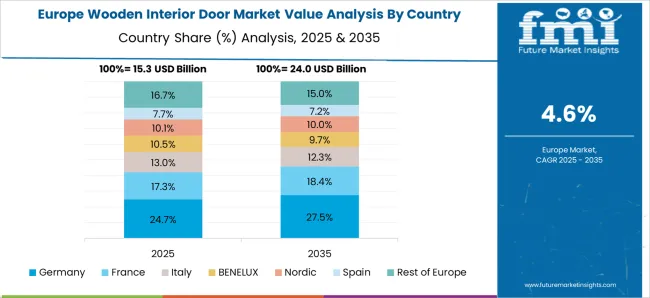
Germany’s wooden interior door market is projected to grow at a CAGR of 5.8% during 2025-2035, higher than the global average of 5.0%. The market grew at a CAGR of 4.7% from 2020 to 2024, driven by strong demand in both residential and commercial construction sectors. The accelerated growth in the next decade is expected to be influenced by Germany’s commitment to sustainability, increasing adoption of energy-efficient building materials, and rising consumer preference for high-quality, aesthetic solutions. Furthermore, as more German homes and offices embrace modern, eco-friendly, and customizable interior designs, the demand for wooden doors made from sustainable wood sources will rise. Germany’s commitment to green building practices and its robust construction industry will continue to support this market.
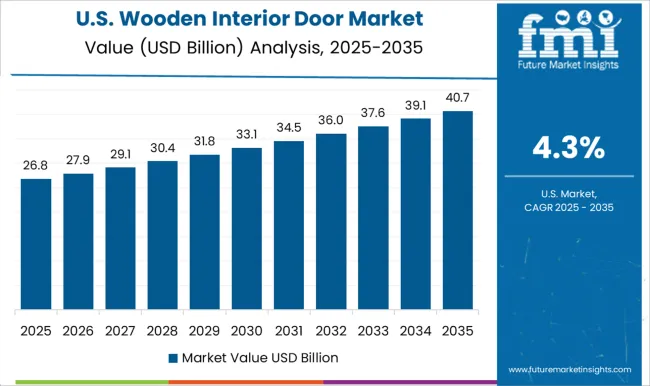
The USA wooden interior door market is expected to grow at a CAGR of 4.3% during 2025-2035. The market grew at a CAGR of 3.7% during 2020-2024, driven by consistent demand from the residential construction and home renovation sectors. The market’s expected rise in the coming decade will be fueled by increased focus on eco-friendly materials, growing consumer preference for energy-efficient doors, and a shift towards high-quality, durable wooden door solutions. The trend towards smart home integration and premium interior designs will also contribute to the demand for high-end wooden interior doors. As the USA embraces energy-efficient, aesthetically pleasing solutions, the demand for wooden interior doors will continue to increase.

The highly reactive polyisobutylene market is driven by prominent global and regional producers focused on delivering specialized polymer grades for lubricants, adhesives, and sealant applications. TPC Group holds a strong position with extensive production capacity and a diverse product portfolio serving both domestic and export markets. RB Products, Inc. emphasizes customized HR PIB solutions for performance additives, catering to industrial and automotive sectors with a strong distribution network. BASF SE leverages its advanced chemical platforms and global presence to provide consistent quality and innovation in HR PIB formulations.
PETRONAS focuses on integration strategies by linking HR PIB production with downstream lubricant operations, ensuring cost efficiency and reliability for end users. Lanxess has built its presence through research-driven solutions targeting high-performance elastomers and polymer modification requirements, reinforcing its share in specialty chemical markets. Kothari Petrochemicals continues to scale operations in Asia with competitive pricing strategies and technical support for adhesive and packaging industries. Mayzo targets niche applications by supplying performance polymers with tailored characteristics, addressing demand in sealing and bonding markets.
Chinese companies such as Jinzhou Snda Chemical, Ningbo Hi-Tech Biochemicals, and Shanghai Minglan Chemical emphasize cost competitiveness and regional supply dominance through high-volume manufacturing. Weifang Binhai Petro-chem and Shandong Hongrui New Material Technology strengthen the local value chain by enhancing production capabilities for industrial-grade HR PIB, ensuring faster delivery cycles. Key strategies shaping this competitive landscape include backward integration to secure raw material supply, product diversification for niche polymer applications, and the establishment of regional distribution hubs to optimize logistics and reduce lead times.
Strategic collaborations with lubricant additive producers and adhesive manufacturers are also being prioritized to drive long-term demand. Continuous investment in process optimization and controlled molecular weight distribution underscores the industry's transition toward efficiency and quality-driven growth in HR PIB applications globally.
Companies are offering bespoke door solutions, where customers can select wood species, finishes, sizes, and panel designs, enabling a tailored look for residential and commercial spaces. Premium finishes like matte or glossy lacquer, varnishes, and wood stains are also in demand to match specific interior themes.
JELD-WEN is one of the top players in the wooden door industry. They focus on offering a wide range of wooden doors that cater to both high-end residential and commercial applications. Their strategy revolves around customization, energy-efficient solutions, and sustainable materials. The company has recently expanded its focus on eco-friendly products, ensuring that its wood sourcing meets green certification standards.
| Item | Value |
|---|---|
| Quantitative Units | USD 62.6 Billion |
| Product Type | Panel Door, Bypass Door, Bifold Door, Pocket Door, and Others |
| Mechanism | Swinging, Sliding, Folding, and Others |
| End-use | Residential, Non-residential, and Others |
| Regions Covered | North America, Europe, Asia-Pacific, Latin America, Middle East & Africa |
| Country Covered | United States, Canada, Germany, France, United Kingdom, China, Japan, India, Brazil, South Africa |
| Key Companies Profiled | Masonite International Corporation, Jeld-Wen Holding, Inc., Steves & Sons Inc., Simpson Door Company, Bayer Built Woodworks Inc., Appalachian Wood Products Inc., Artisan Hardware, Karona Inc., Sun Mountain Inc., TruStile Doors LLC, USA Wood Door, Allegheny Wood Works Inc., Woodgrain Millwork Inc., Bayer Built Woodworks Inc., and Lynden Door Inc. |
| Additional Attributes | Dollar sales by application segments, share by grade and end use, competitive landscape with production capacity, pricing trends by region, growth drivers in lubricant and adhesive sectors, regulatory compliance impact, raw material cost analysis, emerging demand hotspots. |
The global wooden interior door market is estimated to be valued at USD 62.6 billion in 2025.
The market size for the wooden interior door market is projected to reach USD 102.0 billion by 2035.
The wooden interior door market is expected to grow at a 5.0% CAGR between 2025 and 2035.
The key product types in wooden interior door market are panel door, bypass door, bifold door, pocket door and others.
In terms of mechanism, swinging segment to command 44.1% share in the wooden interior door market in 2025.






Our Research Products

The "Full Research Suite" delivers actionable market intel, deep dives on markets or technologies, so clients act faster, cut risk, and unlock growth.

The Leaderboard benchmarks and ranks top vendors, classifying them as Established Leaders, Leading Challengers, or Disruptors & Challengers.

Locates where complements amplify value and substitutes erode it, forecasting net impact by horizon

We deliver granular, decision-grade intel: market sizing, 5-year forecasts, pricing, adoption, usage, revenue, and operational KPIs—plus competitor tracking, regulation, and value chains—across 60 countries broadly.

Spot the shifts before they hit your P&L. We track inflection points, adoption curves, pricing moves, and ecosystem plays to show where demand is heading, why it is changing, and what to do next across high-growth markets and disruptive tech

Real-time reads of user behavior. We track shifting priorities, perceptions of today’s and next-gen services, and provider experience, then pace how fast tech moves from trial to adoption, blending buyer, consumer, and channel inputs with social signals (#WhySwitch, #UX).

Partner with our analyst team to build a custom report designed around your business priorities. From analysing market trends to assessing competitors or crafting bespoke datasets, we tailor insights to your needs.
Supplier Intelligence
Discovery & Profiling
Capacity & Footprint
Performance & Risk
Compliance & Governance
Commercial Readiness
Who Supplies Whom
Scorecards & Shortlists
Playbooks & Docs
Category Intelligence
Definition & Scope
Demand & Use Cases
Cost Drivers
Market Structure
Supply Chain Map
Trade & Policy
Operating Norms
Deliverables
Buyer Intelligence
Account Basics
Spend & Scope
Procurement Model
Vendor Requirements
Terms & Policies
Entry Strategy
Pain Points & Triggers
Outputs
Pricing Analysis
Benchmarks
Trends
Should-Cost
Indexation
Landed Cost
Commercial Terms
Deliverables
Brand Analysis
Positioning & Value Prop
Share & Presence
Customer Evidence
Go-to-Market
Digital & Reputation
Compliance & Trust
KPIs & Gaps
Outputs
Full Research Suite comprises of:
Market outlook & trends analysis
Interviews & case studies
Strategic recommendations
Vendor profiles & capabilities analysis
5-year forecasts
8 regions and 60+ country-level data splits
Market segment data splits
12 months of continuous data updates
DELIVERED AS:
PDF EXCEL ONLINE
Interior Swinging Door Market Size and Share Forecast Outlook 2025 to 2035
Residential Interior Wood Doors Market Size and Share Forecast Outlook 2025 to 2035
Luxury Wood Doors For Residential Interiors Market Size and Share Forecast Outlook 2025 to 2035
Wooden Pallet Rental Service Market Size and Share Forecast Outlook 2025 to 2035
Wooden Crate Market Forecast and Outlook 2025 to 2035
Wooden Cutlery Market Size and Share Forecast Outlook 2025 to 2035
Wooden & Plywood Packaging Market Size and Share Forecast Outlook 2025 to 2035
Wooden Furniture Market Size and Share Forecast Outlook 2025 to 2035
Doors Market Size and Share Forecast Outlook 2025 to 2035
Interior Packaging Market Size and Share Forecast Outlook 2025 to 2035
Wooden Decking Market Size, Growth, and Forecast 2025 to 2035
Wooden Barrels Market Growth - Demand & Forecast 2025 to 2035
Market Share Insights of Wooden Crate Providers
Competitive Breakdown of Interior Packaging Manufacturers
Wooden Box Market Demand & Premium Packaging Trends 2024-2034
Wooden Pallets Market
Door Hardware Market
Wooden Pallet Collars Market
Door Controller Systems Market
Indoor Rotary High Voltage Disconnect Switch Market Size and Share Forecast Outlook 2025 to 2035

Thank you!
You will receive an email from our Business Development Manager. Please be sure to check your SPAM/JUNK folder too.
Chat With
MaRIA